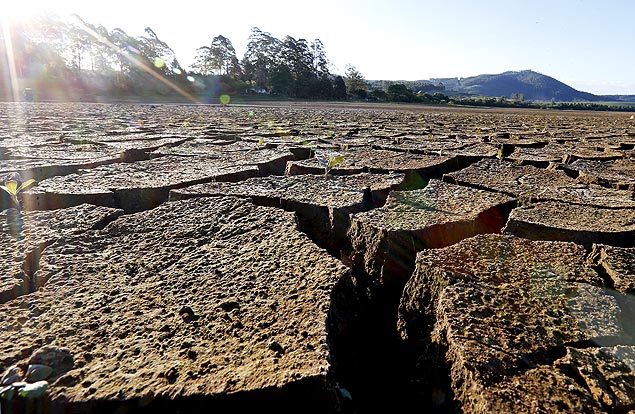Latest Photo Galleries
Brazilian Markets
17h36 Bovespa |
-0,17% | 124.171 |
16h43 Gold |
0,00% | 117 |
16h59 Dollar |
-0,48% | 5,2424 |
16h30 Euro |
+0,49% | 2,65250 |
ADVERTISING
Drought in Southeast Brazil Hits 133 Cities with Consequences for the Economy
11/03/2014 - 09h07
Advertising
FABRÍCIO LOBEL
DHIEGO MAIA
MARCELO SOARES
MARCELO LEITE
FROM SÃO PAULO
The drought in Brazil's southeast region is affecting at least 133 cities and has become a nightmare for their 27.6 million inhabitants.
They account for US$381.6 billion (R$946.4 billion), or 23% of Brazilian GDP, according to data from 2011 (the last year with detailed data for each city).
Adjusted for inflation (17.85%), this figure is today an estimated US$443.5 billion (R$1.1 trillion).
If it were a country, this "polygon of drought" in São Paulo, Minas Gerais and Rio de Janeiro would be the second-largest economy in South America, behind only Brazil as a whole.
If production fell by just 1% in each of the municipalities affected, it would be enough to subtract 0.23% from national GDP.
Economic growth this year is predicted to be 0.3%.
The situation in São Paulo is most serious. Out of 645 municipalities, 92 (14%) are facing some kind of difficulty.
It is difficult to estimate exactly how much the economy will be affected by the water crisis, but companies are already publishing losses.
The Sugarcane Industry Union (UNICA, in its Portuguese acronym) published a projection 2.9% lower for the 2014/15 harvest in the south-central region.
In August, this fell further, to 8.6%. In total, the state of São Paulo is likely to produce 11.71% less sugarcane this year.
In Paulínia (SP), the chemical multinational Rhodia had to impose rationing for a month in four of its 22 plants.
The textile sector has also been affected. According to Rafael Cevone, president of the Brazilian Association of the Textile and Clothing Industry, entire factories are unable to work.
To make matters worse, the price of water tankers has doubled in recent months (from US$242 [R$600] to US $484 [R$1200] for 10,000 liters).
"You can't just blame the drought," said Cevone. "Investments were not made in interconnecting water sources and other construction work, such as improving the capacity of the Guarani aquifer."
The administration of Geraldo Alckmin (PSDB) says that the necessary investments have been made, and blames the crisis on a historic period of drought.
FINES
The survey conducted by Folha regarding the impact of the drought in the southeast covered cities reporting consistent water shortages, such as the city of São Paulo.
At least 61 cities in the region have adopted rationing, and 19 have even imposed fines in order to reduce water consumption.
With additional material from LUCAS VETTORAZZO in Rio de Janeiro and GISELE BARCELOS in Uberaba
Translated by TOM GATEHOUSE
Read the article in the original language
| Ernesto Rodrigues/Folhapress | ||
 |
||
| The drought in Brazil's southeast region is affecting at least 133 cities and has become a nightmare for their 27.6 million inhabitants |



